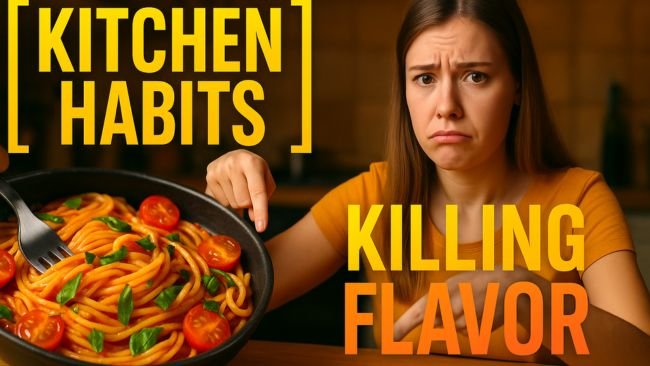Índice do Conteúdo
- Introduction This Mistake Wreks Meals
- Whether You’re 25 or 65, This Makes Cooking Effortless
- 1. Using a Cold Pan to Start Cooking
- Why it ruins your food:
- What to do instead:
- 2. Overcrowding the Pan
- Why it ruins your food:
- What to do instead:
- 3. Not Letting Meat Rest After Cooking
- Why it ruins your food:
- What to do instead:
- Whether You’re 25 or 65, This Makes Cooking Effortless
- 4. Underseasoning (Especially with Salt)
- Why it ruins your food:
- What to do instead:
- 5. Using Dull Knives
- Why it ruins your food:
- What to do instead:
- 6. Not Reading the Full Recipe First
- Why it ruins your food:
- What to do instead:
- Whether You’re 25 or 65, This Makes Cooking Effortless
- 7. Cooking Everything on High Heat
- Why it ruins your food:
- What to do instead:
- Bonus: Mistake #8 – Fear of Experimenting
- What to do instead:
- Kitchen Wisdom
- Key Takeaways:
- FAQ
- Whether You’re 25 or 65, This Makes Cooking Effortless
Introduction This Mistake Wreks Meals
I still remember the first time I tried to impress my friends with a homemade lasagna. I followed the recipe to the letter or so I thought. The result? Mushy noodles, bland sauce, and cheese that somehow evaporated. What went wrong? Turns out, I was making several classic kitchen mistakes without even knowing it.
If you’ve ever wondered why your food doesn’t turn out like the recipes you see online, don’t worry I’ve been there. Over time, I’ve discovered that even tiny errors can completely ruin a dish. Today, I’m sharing the 7 most common kitchen mistakes that silently sabotage your meals and how to fix them.
Whether you’re just starting your cooking journey or looking to level up your skills, this guide will save you from frustration and wasted ingredients.

1. Using a Cold Pan to Start Cooking
Starting with a cold pan is one of the biggest rookie mistakes.
Why it ruins your food:
- Proteins stick
- Uneven browning
- Mushy vegetables
What to do instead:
Always preheat your pan before adding oil or ingredients. You’ll get better texture, color, and flavor every time.
Pro tip: Flick a drop of water into the pan if it dances, it’s ready!
2. Overcrowding the Pan
Cramming too many ingredients into a pan is tempting, especially when you’re in a hurry.
Why it ruins your food:
- Steam replaces searing
- Soggy textures
- Uneven cooking
What to do instead:
Cook in batches. Give your ingredients space to breathe. The flavor payoff is totally worth the extra time.
My experience: I once tried to make a stir-fry for 4 in a tiny skillet. Everything turned grey. Never again.
3. Not Letting Meat Rest After Cooking
Cutting into your steak or chicken right after cooking? That’s a fast track to dry, disappointing meat.
Why it ruins your food:
- Juices escape instantly
- Tough texture
What to do instead:
Let the meat rest for 5–10 minutes, depending on size. Cover it loosely with foil.
Why it works: Resting allows juices to redistribute, keeping your meat juicy and flavorful.

4. Underseasoning (Especially with Salt)
Seasoning is what turns a dish from bland to unforgettable.
Why it ruins your food:
- Flat taste
- No depth of flavor
What to do instead:
Taste as you go. Salt enhances natural flavors and should be layered, not dumped in all at once.
Did you know? Most professional chefs season three or four times during cooking, not just at the end.
5. Using Dull Knives
It’s not just inconvenient it’s dangerous.
Why it ruins your food:
- Sloppy cuts
- Crushed herbs and vegetables
- Increased risk of injury
What to do instead:
Sharpen your knives regularly. A sharp knife gives you control, precision, and makes cooking feel way more enjoyable.
Quick tip: If your knife can’t slice a tomato cleanly, it’s time for a sharpening.
6. Not Reading the Full Recipe First
I’ve been guilty of this more times than I can count.
Why it ruins your food:
- Missed steps
- Timing chaos
- Forgotten ingredients
What to do instead:
Always read the full recipe before you start. It helps with prep, timing, and prevents surprises midway.
Imagine this: You’re halfway through a cake and suddenly realize it needs to chill overnight. Disaster averted by reading ahead!
7. Cooking Everything on High Heat
More heat = faster cooking, right? Not always.
Why it ruins your food:
- Burnt outside, raw inside
- Lost textures and flavors
What to do instead:
Learn to control your heat. Sautéing, simmering, searing, and baking all have different requirements.
Pro tip: Medium heat is often your best friend. Patience pays off.
Bonus: Mistake #8 – Fear of Experimenting
Being too rigid in the kitchen can hold you back from discovering your true cooking potential.
What to do instead:
Start with the basics, but don’t be afraid to tweak flavors or add a personal touch. That’s how great recipes are born!
Kitchen Wisdom
Ask any home cook from São Paulo to San Francisco and they’ll agree the secret to delicious food is respect. Respect your ingredients, respect the process, and respect your own taste. Cook with intention.
Have you made any of these mistakes before? Don’t worry we all have! Which one surprised you the most? Drop a comment and let’s talk kitchen wisdom!
Key Takeaways:
- Preheat pans for better cooking results
- Give ingredients space don’t overcrowd
- Let meat rest before slicing
- Season thoughtfully and taste as you go
- Keep your knives sharp and reliable
- Read recipes fully before starting
- Use appropriate heat levels for different techniques
- Trust yourself don’t fear experimenting

FAQ
Q1: How do I know if I’m underseasoning my food?
A: If your dish tastes flat, bland, or “missing something,” it might need more salt or acidity.
Q2: How often should I sharpen my knives?
A: Ideally every 1–2 months, depending on usage. Honing can be done weekly.
Q3: Can I fix an overcooked dish?
A: Sometimes. Try adding sauces or broths to restore moisture, but prevention is key.
Q4: What’s the biggest mistake beginners make?
A: Rushing through recipes without prep or understanding the technique.
Q5: Is it okay to use substitutions?
A: Yes! Just make sure the substitute complements the dish’s flavor and texture.
Article written by: Mariana Costa – Urban Culinary Researcher @ FeastLoom



